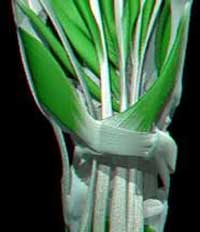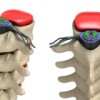
Carpal Tunnel Syndrome is the most commonly referenced Repetitive Motion Injury – a category of conditions that represent the fastest growing segment of injuries in American society today. Many factors have been blamed on this recent epidemic including increased computer usage, poor ergonomics, and improper medical treatment that is focused on symptom masking and not on prevention or correction. The term “carpal tunnel” refers to a tunnel formed by bones of the wrist through which nerves and tendons pass as they travel from the forearm to the hand. Although irritation of the nerves at the carpal tunnel is a common cause of this condition, there are usually other factors. “Trapped” nerves at the spine (usually the neck), pectoralis minor muscle of the chest, rotator cuff muscles of the shoulder and forearm muscles are commonly involved with this condition.
Repetitive “rubbing” of sensitive soft-tissues or chronic muscle tightness will initiate an injury cascade that will eventually lead to significant dysfunction and pain. Both of these situations deprive the soft-tissues of much needed oxygen due to a decrease in full muscle contraction and complete relaxation. This reduces the “pumping” action that normally occurs within healthy muscle tissue. A decrease in tissue oxygenation triggers fibroblastic activity – the primary mechanism involved in the formation of scar tissue. As the scar tissue builds, the tendons passing through the carpal tunnel thicken. This thickening decreases the amount of space available in the tunnel for the nerves. Eventually, the competition for space within the tunnel will lead to a compression of the nerves triggering the typical carpal tunnel symptoms. In other words, carpal tunnel syndrome can develop over months or years before the first symptom is ever experienced!
Treatment for Repetitive Motion Injuries / Cumulative Trauma Disorders
A combined approach of corrective chiropractic adjustments and restorative Active Release Technique muscle work is often the most effective approach.
Scar tissue adhesions located within and between soft-tissues are best removed using a muscle therapy called Active Release, a treatment method that often provides immediate and dramatic results. It is a patented, state-of-the-art soft tissue (muscles, ligaments, fascia and nerves) treatment system that was designed specifically to deal with repetitive motion injuries.
The Active Release doctor uses his hands to evaluate the injured tissue. Then, precisely applied tension is combined with specific patient movements. Treatment is an interactive process involving both doctor and patient and every Active Release session is actually a unique combination of examination and treatment. Patients often notice improvement in their levels of pain, flexibility and strength within seconds following the treatment.
As with any chiropractic procedure, addressing the source of the problem is a must. A chronic joint dysfunction of the neck, shoulder, elbow or wrist can force the muscles of the forearm to become “overworked”. This constant abuse can initiate the inflammatory cascade mentioned above that can eventually end with carpal tunnel syndrome. Chiropractic adjustments commonly correct these dysfunctions allowing the supporting musculature to return to a healthy, balanced state. Treatment of the muscle alone will likely provide only temporary benefit as the dysfunctional joint will merely cause the muscles to become unbalanced again over time. Likewise, ignoring the muscles and only treating the joints will often produce mediocre results as the muscles pull the joints back into dysfunction.
Is Surgery Effective at Treating Carpal Tunnel Syndrome?
Surgical procedures have been developed over the years to “release” the pressure on the nerves at the carpal tunnel by permanently severing the ligament that holds the tunnel together. Unfortunately, these procedures are rarely successful over the long term and almost never address the cause of the nerve irritation. Common sense would tell us that it is unlikely that the carpal tunnel would simply “shrink” without warning. Therefore, increasing the size of the tunnel will only provide temporary benefit especially if the tendons within the tunnel continue to thicken. Also, post-surgical scar tissue can also interfere with proper wrist and nerve function contributing to more pressure on the nerve.
In Feb 2008, I was told I needed to get surgery in both of my hands for Carpal Tunnel Syndrome. I definitely did not want surgery. I quickly started looking for an alternative. I started to Google for a Doctor in Westchester and found Dr. Donath. He started working on my hands right away with the Active Release Treatment, within a few visits the numbness and tingling went away. It is amazing that Dr. Donath was able to relieve the tension with his hands and not with surgery. I was relieved to be able to find a non-surgical solution!
Mika S. White Plains, NY


